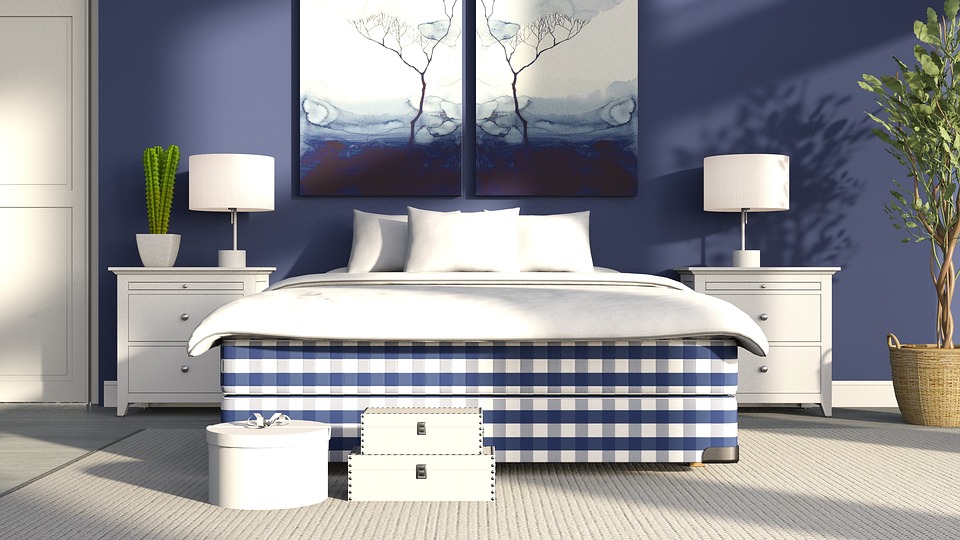
There are multiple ways in which a bedroom color can influence the quality of your sleep. So much so that there are even the best and the worst bedroom colors for sleep. And, since this is not common knowledge even among people who know a thing or two about sleeping, let us take a closer look.
Why Colors Matter
The first thing we need to consider is why colors matter. Besides personal preference, is there a reason why you should paint your bedroom a specific color? Surely, a gray bedroom is just as good as a yellow one when it comes to sleeping. After all, you close your eyes when you sleep, so why would color have any effect on it.
All valid questions and comments. But, studies have shown that the color of our bedroom actually does have a significant impact on our sleep.
Psychology and Colors
As some of you might have guessed, the biggest reason why colors influence our sleep is due to psychology. Perception experts have shown that colors influence our emotions. Now, we need to take a step back and appreciate this fact.
This means that the color of your car, the color of your clothes and the color of your hair will influence both you and the people around you.
.jpg?width=300&name=The%20Best%20and%20Worst%20Bedroom%20Colors%20for%20Sleep%20(2).jpg)
We, as a species, have associated colors to different emotions since the dawn of time. This has led to us attributing values and meaning to colors. And the beauty of it is that it is subconscious. This is why you need to carefully consider the colors that surround you and why there are the best and the worst bedroom colors for sleep.
The more you think about it, the more you will realize how profoundly colors affect us.
How to Associate Colors
Have you ever wondered why red means stop and green means go? Surely we could’ve picked another pair of colors to represent these simple instructions. Well, maybe so. But, we would have to ignore the ages of attributing meanings to colors green and red. Green is often associated with nature and spring. It gives the meaning of evolving and moving forward in a calm way. Red, however, is associated with blood. Therefore it is not hard to attribute death and aggressiveness to red.
There is a good reason why we use green for go and red for stop.
.jpg?width=272&name=The%20Best%20and%20Worst%20Bedroom%20Colors%20for%20Sleep%20(5).jpg)
Once you take that into account, it is easy to realize that if you want your drivers to go in a calm manner, you choose a green light for ’’go’’. And, if you want them to notice a stop sign and focus on it, you use red. These are just some of the ways in which we experience colors, and why you need to consider the colors of your bedroom carefully. If you neglect doing so, you will have a hard time controlling your emotions before going to sleep.
Which are the best and the worst colors for sleep?
So, with all that in mind, which are the best and the worst bedroom colors for sleep? Well, there are multiple. As it is with everything else, there is no one best color for sleep. In order to make your bedroom calm and relaxing, you need to consider the entirety of it. You need to carefully think about the furniture in it, the temperature, the quality of air and about any noises that might bother you. With that, you should try out some of our best colors for sleep and see how they fit. Remember, there is no clear cut solution when it comes to sleep. You need to try out different things and see what works for you.
Best Colors
The best colors for sleep tend to be on the deep, cold spectrum. These are usually dark blue, or heavy green with shades of brown. We associate colors such as these with nature, calmness, and heaviness, which are all beneficial to a good night’s sleep.
You want to have a sense of calmness and tranquility before you lay down and close your eyes. And, one of the best visual representations of calmness and tranquility are big forests, open sky and dusk, and large rivers.
So, when you decide to move to Alaska, paint your bedroom in the colors you see in the Alaskan outdoors. These images will help your mind get calm and relaxed, which is essential for a good night’s sleep.
You only need to take a look at the Alaskan outdoors to see why green and blue are the best bedroom colors for sleep.
You want to use a single shade of color. Multiple shades of color alert your mind and make it more awake. This will make calming your mind and making it sufficiently relaxed needlessly difficult. So, if you want to have an easy time falling asleep, make sure to pick a dark, calming color, and only use it for your bedroom. Do not use any altering patterns or shades.
Worst Colors
.jpg?width=300&name=The%20Best%20and%20Worst%20Bedroom%20Colors%20for%20Sleep%20(4).jpg)
The worst colors you can pick for your bedroom are warm, shiny, aggressive colors. Any color that draws attention does not belong in the bedroom.
Colors like orange, yellow and red are all aggressive and invoke a sense of alertness. Especially if you combine them with black. You can easily see that a lot of poisonous animals have shades of aggressive colors and black intertwined.
A lot of poisonous animals have vibrant color patterns.
If you paint your bedroom in orange and black, you will effectively surround yourself with poisonous animals. And, as you might guess, this is not a nice environment to sleep in.
What else should you consider when painting your bedroom for sleep?
Whatever color you choose, use the lighter, pastel, or muted shades of the color. Neutral, earth- or skin-based tones are calming, and promote positive energy flow according to feng shui.
A color that is too bright or bold will stimulate you, creating a sense of alertness instead a sense of relaxation. Save the statement walls for your living room and keep your bedroom serene.
Use a flat paint instead of an eggshell or glossy finish. Glossy finishes reflect light, while flatter paints absorb more color and feel softer.
Also take care what colors you choose for your bedroom accents. They should complement each other and be parallel to each other on a color wheel, rather than contrasting. Contrasting colors stimulate your eyes and mind.
For some, no change in bedroom color will help them get quality sleep at night. If you are one of these people, you may be living with sleep apnea. The only way to improve your sleep AND your life is with a correct diagnosis and treatment plan. Call Alaska Sleep Clinic today for a FREE consultation with one of our board-certified sleep specialists.











